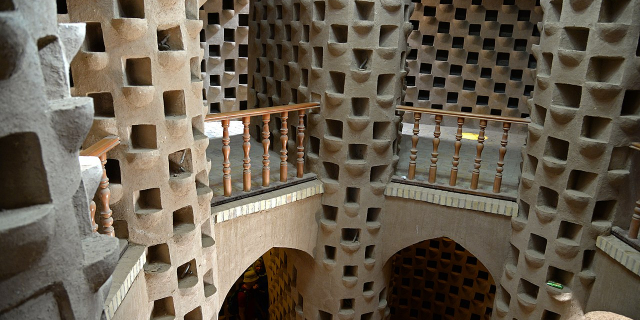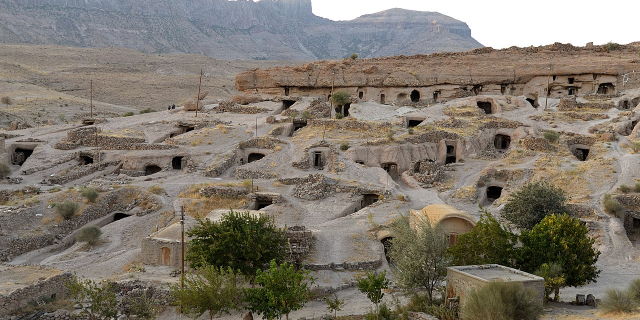Yazd (Persian: یزد [jæzd] ), formerly also known as Yezd, is the capital of Yazd province, Iran. The city is 270 km (170 mi) southeast of Isfahan. At the 2016 census, its population was 529,673. Since 2017, the historical city of Yazd is recognized as a World Heritage Site by UNESCO.
Because of generations of adaptations to its desert surroundings, Yazd has a unique Persian architecture. It is nicknamed the "City of Windcatchers" (شهر بادگیرها Shahr-e Badgirha) from its many examples. It is also very well known for its Zoroastrian fire temples, ab anbars (cisterns), qanats (underground channels), yakhchals (coolers), Persian handicrafts, handwoven cloth (Persian termeh), silk weaving, Persian cotton candy, and its time-honored confectioneries. Yazd is also known as City of Bicycles, because of i...Read more
Yazd (Persian: یزد [jæzd] ), formerly also known as Yezd, is the capital of Yazd province, Iran. The city is 270 km (170 mi) southeast of Isfahan. At the 2016 census, its population was 529,673. Since 2017, the historical city of Yazd is recognized as a World Heritage Site by UNESCO.
Because of generations of adaptations to its desert surroundings, Yazd has a unique Persian architecture. It is nicknamed the "City of Windcatchers" (شهر بادگیرها Shahr-e Badgirha) from its many examples. It is also very well known for its Zoroastrian fire temples, ab anbars (cisterns), qanats (underground channels), yakhchals (coolers), Persian handicrafts, handwoven cloth (Persian termeh), silk weaving, Persian cotton candy, and its time-honored confectioneries. Yazd is also known as City of Bicycles, because of its old history of bike riders, and the highest number of bicycles per capita in Iran. It is reported that bicycle culture in Iran originated in Yazd as a result of contact with European visitors and tourists in the last century.
Archeological evidence 12 kilometers north of Yazd suggests that the area has been populated since the period of the Achaemenid Empire (550 BC–330 BC).[1] In his Natural History, Pliny the Elder (died 79 AD) mentions a town in the Parthian Empire (247 BC–224 AD) named "Issatis", which is seemingly connected to the name of the Asagarta/Istachae/Sagartians.[2] As a result, some scholars have suggested that the name of Yazd was derived from Issatis (also transliterated as Isatichae, Ysatis, Yasatis), and that the latter name started to be used in the Median or Achaemenid eras.[3]
The area encompassing Yazd first started to gain prominence in the Late antiquity, namely under the Sasanian Empire (224–651). Under Yazdegerd I (r. 399–420), a mint was established in Yazd (under the mint abbreviation of "YZ"), which demonstrates its increasing importance.[4] According to the New Persian chronicle Tarikh-i Yazd ("History of Yazd") of 1441, Yazd was re-founded by "Yazdegerd, son of Bahram", i.e. Yazdegerd II (r. 438–457).[5] The word yazd means God.[6] After the Muslim conquest of Persia, many Zoroastrians migrated to Yazd from neighboring provinces. By paying a levy, Yazd was allowed to remain Zoroastrian even after its conquest, and Islam only gradually became the dominant religion in the city.
 Yazd Atash Behram.
Yazd Atash Behram.Due to its secluded desert setting and challenging access, Yazd was mostly spared from major conflicts and the devastation and havoc of warfare. For instance, it was a haven for those fleeing from destruction in other parts of Persian Empire during the Mongol invasion. In 1272 it was visited by Marco Polo, who remarked on the city's fine silk-weaving industry. In the book The Travels of Marco Polo, he described Yazd in the following way:
It is a good and noble city, and has a great amount of trade. They weave there quantities of a certain silk tissue known as Yasdi, which merchants carry into many quarters to dispose of. When you leave this city to travel further, you ride for seven days over great plains, finding harbour to receive you at three places only. There are many fine woods producing dates upon the way, such as one can easily ride through; and in them there is great sport to be had in hunting and hawking, there being partridges and quails and abundance of other game, so that the merchants who pass that way have plenty of diversion. There are also wild asses, handsome creatures. At the end of those seven marches over the plain, you come to a fine kingdom which is called Kerman.
Yazd briefly served as the capital of the Muzaffarid Dynasty in the fourteenth century, and was unsuccessfully besieged in 1350–1351 by the Injuids under Shaikh Abu Ishaq. The Friday (or Congregation) mosque, arguably the city's greatest architectural landmark, as well as other important buildings, date to this period. During the Qajar dynasty (18th century AD) it was ruled by the Bakhtiari Khans.
Under the rule of the Safavids (16th century), some people migrated from Yazd and settled in an area that is today on the Iran-Afghanistan border. The settlement, which was named Yazdi, was located in what is now Farah City in the province of the same name in Afghanistan. Even today, people from this area speak with an accent very similar to that of the people of Yazd.
One of the notable things about Yazd is its family-centered culture. According to official statistics from Iran's National Organization for Civil Registration, Yazd is among the three cities with the lowest divorce rates in Iran.[citation needed]





























Add new comment